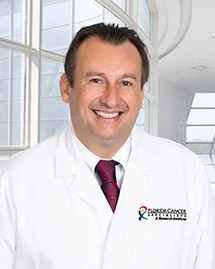Author(s): David R. Spigel, MD1; Corinne Faivre-Finn, MD, PhD2; Jhanelle E. Gray, MD3; David Vicente, MD4; David Planchard, MD, PhD5; Luis Paz-Ares, MD, PhD6; Johan F. Vansteenkiste, MD, PhD7; Marina C. Garassino, MD8,9; Rina Hui, PhD10; Xavier Quantin, MD, PhD11; Andreas Rimner, MD12; Yi-Long Wu, MD13; Mustafa Özgüroğlu, MD14; Ki H. Lee, MD15; Terufumi Kato, MD16; Maike de Wit, MD, PhD17; Takayasu Kurata, MD18; Martin Reck, MD, PhD19; Byoung C. Cho, MD, PhD20; Suresh Senan, PhD21; Jarushka Naidoo, MBBCH, MHS22; Helen Mann, MSc23; Michael Newton, PharmD24; Piruntha Thiyagarajah, MD23; and Scott J. Antonia, MD, PhD3 on behalf of the PACIFIC Investigators
PURPOSE
The phase III PACIFIC trial compared durvalumab with placebo in patients with unresectable, stage III non–small-cell lung cancer and no disease progression after concurrent chemoradiotherapy. Consolidation durvalumab was associated with significant improvements in the primary end points of overall survival (OS; stratified hazard ratio [HR], 0.68; 95% CI, 0.53 to 0.87; P = .00251) and progression-free survival (PFS [blinded independent central review; RECIST v1.1]; stratified HR, 0.52; 95% CI, 0.42 to 0.65; P < .0001), with manageable safety. We report updated, exploratory analyses of survival, approximately 5 years after the last patient was randomly assigned.
METHODS
Patients with WHO performance status 0 or 1 (any tumor programmed cell death-ligand 1 status) were randomly assigned (2:1) to durvalumab (10 mg/kg intravenously; administered once every 2 weeks for 12 months) or placebo, stratified by age, sex, and smoking history. Time-to-event end point analyses were performed using stratified log-rank tests. Medians and landmark survival rates were estimated using the Kaplan-Meier method.
RESULTS
Seven hundred and nine of 713 randomly assigned patients received durvalumab (473 of 476) or placebo (236 of 237). As of January 11, 2021 (median follow-up, 34.2 months [all patients]; 61.6 months [censored patients]), updated OS (stratified HR, 0.72; 95% CI, 0.59 to 0.89; median, 47.5 v 29.1 months) and PFS (stratified HR, 0.55; 95% CI, 0.45 to 0.68; median, 16.9 v 5.6 months) remained consistent with the primary analyses. Estimated 5-year rates (95% CI) for durvalumab and placebo were 42.9% (38.2 to 47.4) versus 33.4% (27.3 to 39.6) for OS and 33.1% (28.0 to 38.2) versus 19.0% (13.6 to 25.2) for PFS.
CONCLUSION
These updated analyses demonstrate robust and sustained OS and durable PFS benefit with durvalumab after chemoradiotherapy. An estimated 42.9% of patients randomly assigned to durvalumab remain alive at 5 years and 33.1% of patients randomly assigned to durvalumab remain alive and free of disease progression, establishing a new benchmark for standard of care in this setting.
Author Affiliations
1Sarah Cannon Research Institute/Tennessee Oncology, Nashville, TN 2The University of Manchester and The Christie NHS Foundation Trust, Manchester, United Kingdom 3H. Lee Moffitt Cancer Center and Research Institute, Tampa, FL 4Hospital Universitario Virgen Macarena, Seville, Spain 5Department of Medical Oncology, Thoracic Unit, Gustave Roussy, Villejuif, France 6Universidad Complutense, CiberOnc, CNIO and Hospital Universitario 12 de Octubre, Madrid, Spain 7University Hospitals KU Leuven, Leuven, Belgium 8Fondazione IRCCS Istituto Nazionale dei Tumori, Milan, Italy 9Department of Hematology/Oncology, The University of Chicago, Chicago, IL 10Westmead Hospital and the University of Sydney, Sydney, New South Wales, Australia 11Montpellier Cancer Institute (ICM) and Montpellier Cancer Research Institute (IRCM), INSERM U1194, University of Montpellier, Montpellier, France 12Department of Radiation Oncology, Memorial Sloan Kettering Cancer Center, New York, NY 13Department of Pulmonary Oncology, Guangdong Lung Cancer Institute, Guangdong Provincial People’s Hospital & Guangdong Academy of Medical Sciences, Guangzhou, China 14Istanbul University—Cerrahpaşa, Cerrahpaşa School of Medicine, Istanbul, Turkey 15Chungbuk National University Hospital, Chungbuk National University College of Medicine, Cheongju, Republic of Korea 16Kanagawa Cancer Center, Yokohama, Japan 17Vivantes Klinikum Neukölln, Berlin, Germany 18Department of Thoracic Oncology, Kansai Medical University Hospital, Osaka, Japan 19Lung Clinic Grosshansdorf, Airway Research Center North, German Center for Lung Research, Grosshansdorf, Germany 20Department of Internal Medicine, Yonsei Cancer Center, Yonsei University College of Medicine, Seoul, Republic of Korea 21Department of Radiation Oncology, Amsterdam University Medical Centers, Vrije Universiteit Amsterdam, Cancer Center Amsterdam, Amsterdam, the Netherlands 22Sidney Kimmel Comprehensive Cancer Center and Bloomberg-Kimmel Institute for Cancer Immunotherapy at John Hopkins University, Baltimore, MD 23AstraZeneca, Cambridge, United Kingdom 24AstraZeneca, Gaithersburg, MD
